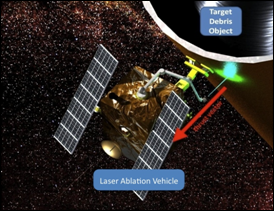Sponsor: US Air Force
Collaborators: Aurora Flight Sciences (John Merk – Co-I)

Orbital debris, both large and small, poses a significant hazard to operating spacecraft. The small debris objects (up to a few cm) might pose the greatest risk due to their abundance and the inability to track them in orbit. However, large debris objects – through both explosions and collisions – provide a continually renewed source of small debris. This was most recently seen in the aftermath of the collision of an out-of-service Russian COSMOS satellite and an IRIDIUM communication satellite in February, 2009.
At present, new spacecraft are required to remove themselves from crowded orbits and/or de-orbit entirely at end of life. However, it is often in the best financial interests of a satellite’s owner to operate it until an unrecoverable failure occurs, significantly reducing the chances the satellite could remove itself from orbit. Once they are inoperable, there are a number of technical challenges to removing full-size derelict objects from crowded orbits, most notably the required propellant and thus launch cost.
A dedicated debris removal vehicle (tug) would resolve the problem of satellites failing before they could be properly disposed, however the effectiveness of such a vehicle is limited by its onboard propellant. This approach would be impractical for vehicles utilizing standard propulsion schemes, as it would only be feasible to remove one debris vehicle per launch. Alternatively, a spacecraft that could utilize existing, on-orbit propellant resources would avoid this problem by launching with only enough propellant to reach its first resource location.
With this in mind, the UMD SPPL in collaboration with Aurora Flight Sciences is evaluating a system for orbital debris remediation that uses laser ablation of an existing on-orbit derelict spacecraft to generate propulsion for its own de-orbit. A low-mass remediation vehicle (see Fig. 1) would arrive at the location of a debris object, attach itself, and then through laser ablation of the debris vehicle mass fly the tandem pair to a designated orbit. After depositing the debris in the desired orbit, the remediation vehicle would retain a portion of the object for use as propellant to fly to its next target of opportunity where the process would repeat. In this way, many debris objects could be removed from high-risk orbits by a single vehicle.